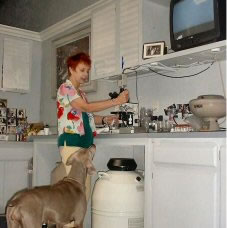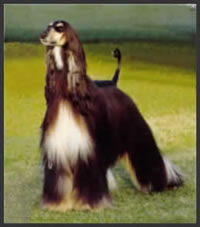Canine frozen semen was being pooh-poohed at the Theriogenology meeting in Denver in 1984. At that time we had a 100% conception rate. I was intimidated by all the learned academics saying frozen semen didn't work and didn't say anything! But, I'll never forget a veterinarian in the audience and telling the professor, who had just announced poor conception rates at her institution, "Gee, I just had a frozen semen litter with frozen semen from Canine Cryobank and I never handled the stuff before!"
![]()

Shipping
cooled semen:
a service
every small animal practitioner can provide
Within
two months of the AKC announcement to allow cooled (not frozen) semen
litters, we had a cooled semen litter of five Dachshunds in Hawaii.
We had six out of eight litters in Japan using cooled Beagle semen.
Our shipping kits are sent to any veterinarian wanting to provide this
service for their clients. I take pride in the fact that our shipping
kit was computer tested years ago and now other marketing companies
use the same packaging kit.
Commitment
to ongoing research
Research
has been ongoing in spite of the fact that we are not funded nor joint
ventured with any big money firms. Our research has always ended up
helping breeders directly or indirectly. We were using progesterone
testing (1988) before the in-house Elisa tests became available. Two
firms now manufacturing in-house progesterone tests used our data to
develop their kits. When we couldn't find institutions addressing our
concerns we conducted our own research. Which mycoplasma species should
we be concerned about? Does mycoplasma have any correlation to post
thaw results? Does any bacteria affect post thaw results?
During
our first decade,
only one other
facility's frozen semen impressed me
Whenever
I thawed semen from George Govette of C.L.O.N.E., I was thrilled! When
I contacted him about changing our protocols to match those he developed,
George in Pennsylvania had more non-surgical frozen semen litters on
the ground than all frozen semen facilities combined . He had developed
a freeze and thaw protocol that was much simpler than ours for the inseminating
veterinarians to successfully master.
Also Govette
shared my concern that due to lack of frozen semen litter success by
a Smith Kline start up company, that company had started promoting surgical
insemination of frozen semen to breeders and veterinarians. George and
I were demoralized that due to lack of research of the "moneyed"
company, bitches would be subjected to unnecessary surgery. We agreed
to cooperate to try to promote the use of frozen semen with non-surgical
inseminations.
Our
goals of education and accessible service
Education
and resources for breeders and veterinarians have a high priority. Besides
lecturing all over the world, we hold seminars monthly. Our artificial
insemination kits, videotape, books, are used in Universities, Colleges,
and by breeders worldwide. Our seminars concentrate on reproductions
assessments and treatments for the bitch and stud. It is our intent
to make breeders educated consumers of veterinary reproductive medicine.
We are seeing clients in our San Diego facility, and continue to provide
unique and quality service for our clientele.
Our
first decade was exciting, progressive and satisfying. Our next decade
is proving to be more innovative and dynamic. If we can help your or
your clients in any way, please contact us!

High-Flying Victory

Frozen Semen
Litters Worldwide
over the years — litters from long-stored semen
We haven't had to change our extenders over the years. Steve Broder, our cryobiologist, always had a magic touch for single cell cryopreservation. Semen frozen by Priscilla, Steve, or me with his extender from 1983 was producing litters in 1991: An Irish Setter litter (Steve), a Belgian Tervuren litter (Priscilla), and a Great Dane litter (Carol).
Litters from semen shipped in
Our inseminations using semen from other companies is acceptable. We have produced frozen semen litters with every operating bank's sperm.
The
litters keep arriving,
no progesterone testing
or surgical inseminations in those days
After
the first litter, we shipped semen seven times and had six litters. All
litters were produced by veterinarians using whatever artificial insemination
method they happened to know. Back then, the only training we offered
was one page of written thaw instructions. Those were the days before
progesterone testing and surgical inseminations. Now, of course, we have
a videotape on artificial insemination equipment. In our clinic, we now
place semen in the oviducts in a non-surgical procedure, do surgical inseminations,
and us the "old method," intervaginal inseminations. Canine
Cryobank, Inc. purposefully developed its Freeze/Thaw process and services
so that a private practice veterinarian may successfully inseminate with
thawed semen.
After
realizing that
we couldn't do it alone,
we found a reproduction specialist
Steve
and I realized during the first year of operation that canine frozen semen
was not going to be the multi-million dollar business that human sperm
banking is today. First, dog people want a certain stud and nothing can
dissuade them to switch dogs. Dog owners are concerned about inheritable
genetic disease and phenotype. People going to a human sperm bank never
ask about the genetic makeup of the sperm besides hair color, height,
and race. They do often ask if the donor was a student in a professional
discipline. Dog owners will decide on a particular stud and move heaven
and earth to breed to that dog!
The
other reason custom semen banking for dogs would always be limited:
Not enough semen was capable of withstanding the processing. The incidence
of infertility was dramatic in purebred dogs and we had no way of helping
those dogs. We needed a reproduction specialist.
In
1984 after finding out there were very few small animal reproduction
specialists, we convinced Priscilla Stockner to move to California and
start her specialty practice in conjunction with the sperm bank. She
was uniquely qualified for our growing business. Besides her veterinary
degree, Priscilla had a Master's in Reproductive Physiology and an MBA.
And, just as important as her research and academic background, she
had been an active dog enthusiast, raising, showing and hunting several
breeds.
Other
veterinarians became licensees
including one from Europe and Japan
Priscilla
wanted to educate other veterinarians in reproduction protocols for
the serious breeder and fancier. She and I traveled all over the world
lecturing on small animal reproduction for the practitioner. Over the
years we trained nine veterinarians in reproduction assessment and secondarily,
in frozen semen procedures. We always made it very clear to our licensees
that frozen semen would be a limited "hook" for their practice.
Any increased revenues would be generated from the much needed reproductive
protocols.
Our
licensees are enthusiastic, dedicated progressive veterinarians from
all areas of the country, Japan, and Belgium. They traveled to California
and spent two days training with Priscilla in all facets for reproduction
assessment and treatment. All of our licensees have had frozen semen
litters or have frozen semen that produced frozen semen litters.
Canada
didn't have a frozen semen litter
we
accepted the challenge of international shipping
International
shipping of semen is complicated and, at times, frustrating. We were
proud to have a litter in Sweden the first year in business, not realizing
that one litter means people want you to send it again! The Canadian
Kennel Club told us there had never been a litter in Canada. So, we
gritted our teeth when working with the import regulations and Canine
Cryobank had the first frozen semen litter in Canada --eleven Borzois.
Licensee Dr. Betty Trainor sent semen to South Africa and Dr. Dan Bruke,
licensee in New Mexico, sent semen to Australia. Betty's litter was
eleven Rhodesian Ridgebacks and Dan's was seven Soft Coated Wheaten
Terriers.